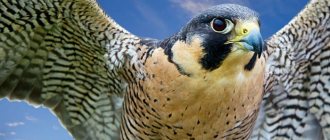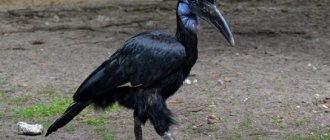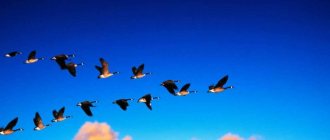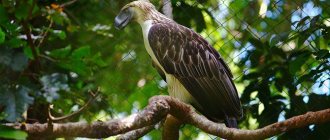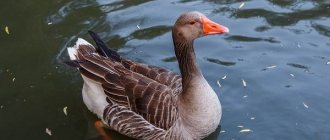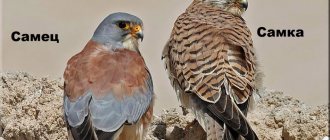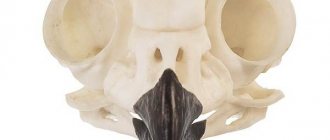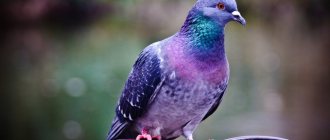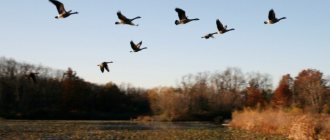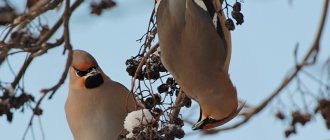- Where do hawks live?
One of the most dangerous, fast and furious predators among birds, of course, is the hawk, which has been noticed by people for its qualities since ancient times. It got its name due to the speed and swiftness of its flight; the word “astr” means “fast”, “swift”. Thus, the word “hawk” can be translated as “a bird with swift, swift flight.” And this characteristic accurately describes the essence of a hawk.
What is an eagle capable of?
The bird has impressive dimensions, body length can reach 90 cm, and weight ranges between 6 kg. Interestingly, the female is often larger than the male. Their muscles are well developed and their legs are particularly strong. The claws are incredibly sharp and almost the size of a human finger. The strong beak makes this predator truly terrifying. Its wings reach a span of 2.5 meters, which allows it to soar above the ground for a long time, watching the desired prey.
Thanks to its acute vision, the predator can spot even the smallest prey at a distance of 3 km. Even with strong gusts of wind, the bird can easily cross the airspace without fear of being carried away. It can reach speeds of up to 300 km/h when it sees prey.
Eagles have a poor sense of smell, but this does not prevent them from catching prey.
Nesting
For nesting, buzzards look for high places from which the area is clearly visible, where enemies cannot get through and destroy the chicks. These could be tall trees, rock ledges, or power poles.
It also happens that even an old crow’s nest can be suitable, if you are lucky enough to find it, then the birds will not have to waste time and energy searching for material and building it. The nest is built from branches, wool, leaves, feathers, dry cereals, dry manure, rags and hair.
Hawks mate for life and are monogamous birds. In early April, the female lays from 2 to 5 eggs. They are usually whitish in color with brown spots.
The eggs are incubated for 35 days, and the chicks are fed in the nest for approximately 6 weeks. The female incubates the eggs and the male brings her food. The chick hatching from the egg has an ocher-colored fluff; after some time it changes to a gray tint.
Usually, chicks hatched from the shell are helpless and defenseless. The parents take turns getting food for them and bringing them to the nest.
At first, the elders tear the prey into pieces so that the chicks can swallow it. Later, they leave the whole prey in the nest and fly away, so that the chicks themselves learn to tear it apart with their beaks.
This is how a kind of education occurs. When the chicks have already grown up and are ready to fly, they sit on the branches for a long time and watch the surrounding nature from above.
How strong is a hawk
These birds are smaller in size than eagles: their weight reaches 1.5 kg, and their body length does not exceed 60 cm. The wingspan is 30 cm. They are distinguished by amazing vision, which is 8 times better than normal human vision.
Large eyes, slightly turned forward, enable birds to use binocular vision, thereby seeing any object with both eyes at the same time.
Powerful leg muscles, sharp claws - all this helps the predator capture its prey instantly. It has special dexterity, because due to its small size, this bird is capable of performing various maneuvers in the air; it can suddenly take off and attack its prey unexpectedly. She has excellent hearing and sense of smell, but the interesting thing is that she distinguishes smells not with her nose, but with her mouth due to a special anatomical location. Having caught the prey, the hawk clings to it with its claws, instantly suffocating it. It eats the prey completely, even feathers and bones.
White tailed eagle
It's time to mention predators that are not so common and are classified as rare. And these birds in Russia in 2013 were even declared heroes of the year, since they desperately need protection, which is noted in the Red Book. Whitetails are quite large and sometimes reach 7 kg in weight.
Their color is replete with brown, yellowish and white shades. They are similar to golden eagles, but their tail is wedge-shaped and short, and the feathers of the limbs do not hide the paws to the toes, like those of these brothers. They nest in the crowns of deciduous trees. They hunt waterfowl and fish, as they prefer to settle near bodies of water.
Eagles are able to see the location of fish underwater from above.
Who is stronger: an eagle or a hawk?
The main difference between a hawk and an eagle is that the latter is large. So in any fight the latter will have the advantage. In addition, its huge and sharp claws can plunge into a hawk with lightning speed, and then the second one will have no chance to survive. Most often, these birds act as rivals because of the prey they see, but the hawk has a chance to evade its opponent thanks to its incredible agility and ability to maneuver when flying without crashing into trees and other obstacles. Therefore, there may be many options for the outcome of events, but still the eagle is much stronger and more powerful than its opponent.
Thus, the hawk has no chance when attacked by an eagle, because it has large dimensions and can kill its prey in a matter of seconds. But if the fight takes place in the forest, among a large number of trees, then the hawk may well fly away from the eagle and hide for a while. His advantage is that he is smaller and more dexterous, and also has the best vision and ingenuity.
Many bird lovers have always admired the strength and power of some birds. This is especially true for such individuals as the eagle and the hawk, because many land animals are afraid of them and try in every possible way to avoid contact with them. I wonder who is stronger: an eagle or a hawk? What an eagle can do The bird has impressive dimensions, its body length can reach 90 cm, […]
Nutrition
As we already wrote above, hawks are incorrigible predators; the basis of their diet consists of smaller birds, small mammals, fish,
frogs, snakes, can attack and eat even large insects. But their favorite food is the same feathered smaller birds: sparrows, finches, finches, wrens, thrushes, tits. Sometimes hawks can attack larger woodpeckers, pheasants, pigeons, crows, parrots, and even hunt domestic chickens. Among the mammals that go to hawks for lunch are mice, rats, voles, squirrels, rabbits, and hares. But Japanese hawks sometimes even hunt bats.
During a hunt, cunning hawks first lie in wait for their prey, then unexpectedly and swiftly attack it. At the same time, hawks are capable of equally dexterously catching both sitting and flying prey. Grabbing her with his powerful paws, he squeezes her tightly, while piercing her with his sharp claws. After this, it eats its victim.
But what do little hawks eat? These young predators eat worms, flies and
mosquitoes
What is an eagle capable of?
The bird has impressive dimensions, body length can reach 90 cm, and weight ranges between 6 kg. Interestingly, the female is often larger than the male. Their muscles are well developed and their legs are particularly strong. The claws are incredibly sharp and almost the size of a human finger. The strong beak makes this predator truly terrifying. Its wings reach a span of 2.5 meters, which allows it to soar above the ground for a long time, watching the desired prey.
Thanks to its acute vision, the predator can spot even the smallest prey at a distance of 3 km. Even with strong gusts of wind, the bird can easily cross the airspace without fear of being carried away. It can reach speeds of up to 300 km/h when it sees prey.
Eagles have a poor sense of smell, but this does not prevent them from catching prey.
How strong is a hawk
These birds are smaller in size than eagles: their weight reaches 1.5 kg, and their body length does not exceed 60 cm. The wingspan is 30 cm. They are distinguished by amazing vision, which is 8 times better than normal human vision.
Large eyes, slightly turned forward, enable birds to use binocular vision, thereby seeing any object with both eyes at the same time.
Powerful leg muscles, sharp claws - all this helps the predator capture its prey instantly. It has special dexterity, because due to its small size, this bird is capable of performing various maneuvers in the air; it can suddenly take off and attack its prey unexpectedly. She has excellent hearing and sense of smell, but the interesting thing is that she distinguishes smells not with her nose, but with her mouth due to a special anatomical location. Having caught the prey, the hawk clings to it with its claws, instantly suffocating it. It eats the prey completely, even feathers and bones.
Who is stronger: an eagle or a hawk?
The main difference between a hawk and an eagle is that the latter is large. So in any fight the latter will have the advantage. In addition, its huge and sharp claws can plunge into a hawk with lightning speed, and then the second one will have no chance to survive. Most often, these birds act as rivals because of the prey they see, but the hawk has a chance to evade its opponent thanks to its incredible agility and ability to maneuver when flying without crashing into trees and other obstacles. Therefore, there may be many options for the outcome of events, but still the eagle is much stronger and more powerful than its opponent.
Thus, the hawk has no chance when attacked by an eagle, because it has large dimensions and can kill its prey in a matter of seconds. But if the fight takes place in the forest, among a large number of trees, then the hawk may well fly away from the eagle and hide for a while. His advantage is that he is smaller and more dexterous, and also has the best vision and ingenuity.
If you were unable to pass by a bird in trouble, you can always seek help from any of the BIRD AND ANIMAL HELP CENTERS, where they will help you with advice, recommendations, and will also see you as a patient.
We have compiled a list especially for you; almost all centers have groups of the same name
RUSSIA •Arkhangelsk - Help for birds, 8-902-197-65-12, 8-911-688-58-90 https://vk.com/sosbird •Barnaul - “Noah’s Ark” https://vk.com/ club144338991 •Voronezh - Wild Animal Rehabilitation Center https://vk.com/wild_animal_vrn •Ekaterinburg - Birds of Prey Nursery "Holzan", 8-952-133-00-73, 8-929-222-86-73 https:// vk.com/public119626574 •Kazan - Birds of Prey Rehabilitation Center, 8-937-294-13-36 https://vk.com/save_birds •Kaliningrad - Klyukvennoe shelter, 8-952-790-74-80 https://vk.com/public88191314 •Kemerovo - Help for wild and exotic animals, 8-923-600-03-62 https://vk.com/birds42 •Kirov - Help for birds https://vk.com/savebirds43 •Komsomolsk-on-Amur - Olga Shcherbakova, https://vk.com/love4aya •Krasnoyarsk - Help for wild animals and birds https://vk.com/kras_wild_help •Michurinsk - Falcon Yard “Wings of Science City”, 8-999- 621-73-89, 8-920-236-38-36 https://vk.com/tmb_rusfalcon •Moscow - Maria Markina, https://vk.com/redtabby, 8-985-641-80-16 https ://vk.com/redtabby •Novgorod the Great - Novgorod Falcon Yard https://vk.com/sd_nov •Novosibirsk - Birds of Prey Rehabilitation Center, 8-983-123-28-92, 8-913-375-21- eleven
https://vk.com/birds54 •Noginsk - “Bottom of the Swamp” Wild Bird Assistance Center, 8-917-517-54-79, SMS ONLY
• Perm - https://vk.com/club125158585 • Petrozavodsk - Galina Belova, https://vk.com/astriell • Rostov-on-Don - Center for Monitoring and Rehabilitation of Birds of Prey, 8-989-704-84- 82
https://vk.com/club.orlan • Ryazan - Anastasia Kozlovskaya, https://vk.com/ak051 • Samara - , 8-937-207-09-66 • St. Petersburg - Center for Rehabilitation and Introduction of Wild Animals “Sirin”, 8-953-374-87-80, 8-921-428-30-72 https://vk.com/seirenru •Smolensk - Smolensk Poozerye National Park, 8-920-305-36- 43 •Tambov - Center for Rescue of Birds of Prey, 8-920-305-36-43 https://vk.com/club135060841 •Tver Region - Rehabilitation Center for Wild Animals "Romashka"
https://vk.com/club114776276 •Togliatti - Bird shelter, 8-967-490-15-44 https://vk.com/club66587109 •Tomsk - Phoenix Rehabilitation Center for Wild Animals and Birds, 8-913 -103-54-51
https://vk.com/ptic_and_ani •Tyumen - Ruslan Manzurov, 8-922-049-73-33 https://vk.com/mansurov_rus •Ulyanovsk - Volunteer Center for Rescue of Wild Animals, 8-906-140-81- 52
•Galich – Center for rehabilitation and introduction of wild animals
•Zaporozhye - Help for birds. Rescue of wild animals https://vk.com/club75642407
If there are no volunteers or center in your locality, contact the nearest one. DO NOT give the bird to “good hands”/zoo/vet clinic! Zoos almost never accept animals from individuals. persons, and in vet. It is not often possible to find a qualified ornithologist veterinarian in clinics.
What to do if you find a bird:
1. Place the bird in a box with ventilation in the walls, put napkins, soft cloth (without protruding threads), and hay on the bottom. Try not to disturb the bird again. DO NOT PUT A BIRD IN A CAGE UNDER ANY EVENT!
Interesting Facts
- In some places, small birds live under the nests of hawks.
hummingbird The fact is that hummingbirds are not of gastronomic interest to hawks, but their natural enemies: jays and squirrels, on the contrary, are very interesting. Thus, hummingbirds, with the help of hawks, protect themselves from squirrels.
What is the difference between a hawk and a falcon?
- Falcons are diurnal birds of prey that belong to the order Falconiformes, family Falconidae, genus Falcons. Hawks are diurnal birds of prey that belong to the order Accipitridae, the family Accipitridae.
- Falcons are larger in size compared to hawks. The body length of the largest representative of hawks, the goshawk, is 52-68 cm, the wing length reaches 30-38 cm, the wingspan does not exceed 1 meter, and the bird weighs from 700 g to 1.5 kg. The largest falcon, the gyrfalcon, has a body length of up to 65 cm, a wingspan of up to 160 cm, while males weigh about 1.3 kg, and the weight of females can reach just over 2 kg.
- The falcon's wings are sharp (wedge-shaped) and reach more than 30 cm in length. The hawk, on the contrary, has blunt and shorter wings, usually reaching less than 30 cm in length.
On the left is a Mexican falcon, on the right is a black and white hawk.
- Hawks do not have a pronounced tooth on the beak, characteristic of falcons.
- The color of the falcon's iris is dark brown, while hawks' eyes are mostly yellow.
- On the palatal surface of the beak of hawks there is no longitudinal ridge, which falcons have.
- Falcons have a short tail, hawks have a longer one.
On the left is a Mexican falcon, on the right is a Cooper's hawk.
- Falcons and hawks hunt differently and therefore live in different types of terrain. Hawks hunt in forests by flying and looking for prey among the trees. Falcons need large steppe spaces, as they pounce on prey quickly, from a great height and at high speed. In addition, these birds kill their prey in different ways: hawks grab it with their claws and strangle it, and falcons use their hind claws to tear it apart, and then, picking it up, finish it off with their beak.
- To breed chicks, falcons often use other people's nests that are suitable in size, or arrange primitive bedding when nesting on rocks. Hawks rarely use other people's nests, but they build their own thoroughly, since sometimes they use them more than once.
On the left is a gyrfalcon (the largest falcon), on the right is a goshawk.
Reproduction of eagles
Puberty of females and males occurs at the age of 4-6 years, even before the acquisition of adult feather “outfit”. Eagles choose their partner and remain faithful to each other for many years. The mating season depends on the degree of sedentism; in migratory species it lasts from mid-winter to April.
Mating games of eagles are characterized by spectacular aerial figures involving both members of the pair: chasing each other, undulating flight, sharp dives, spiral rotation.
The nesting territory is closely guarded from other predators, and the eagle’s nest itself is built high in the branches of trees, on rocky ledges and in niches. Sometimes eagles may choose geodetic towers and supports of high-voltage mains for nesting.
A pair of eagles can use the same nest for several seasons in a row, completing and renovating their home.
The clutch contains from 1 to 3 eggs, gray-white with dark spots. Laying occurs with a difference of 3-4 days.
Incubation of the clutch lasts 40-45 days, with the male sometimes replacing the female eagle.
Covered with grey-white fluff, eagle chicks hatch in the same order as the eggs are laid. The first cub has a better chance of survival by being aggressive towards its siblings. Parents are completely indifferent to this behavior of the first offspring.
The helpless chicks are fed by the female eagle, tearing the prey brought by the male into small pieces. At 65-80 days, the stronger chicks take wing and fly out of the nest, although in the first year of life they rarely leave the nesting territory.
back to contents
What is the difference between a hawk and a kite?
- The kite has shorter and weaker fingers and tarsus, as well as weakly curved claws, unlike the hawk.
- The hawk's tail is rounded or straight-cut, while the kite's has a strongly notched tail.
On the left is the kite Milvus aegyptius, on the right is the striped hawk.
- Kites have a more elongated and weaker beak than hawks.
- The wings of a kite are longer than those of a hawk.
On the left is a red kite, on the right is a collared hawk.
- Both species build their nests themselves, but the kite often nests in groups, forming colonies.
- The kite's diet is different from that of the hawk, which mainly eats birds and less often catches small mammals, insects, amphibians and fish. The kite is able to feed on carrion and garbage, amphibians and reptiles, insects and small mammals, bird eggs, chicks, worms, crabs, snails and mollusks. Birds do not always form the basis of his diet. Also, kites sometimes steal food from other birds: herons, ibises and birds of prey. Some species of kites can even land on the water while fishing, swim and then take off from the water (for example, the Brahminy kite - Haliastur indus). When gathering in flocks, kites can attack large birds of prey: eagles and others. The same Brahmin kite sometimes feasts on honey, ruining the hives of bees.
Video
And in conclusion, an interesting documentary about hawks from the National Geographic channel called “Goshawk - Phantom of the Forest.”
Author: Pavel Chaika, editor-in-chief of Poznavaika magazine
When writing the article, I tried to make it as interesting, useful and high-quality as possible. I would be grateful for any feedback and constructive criticism in the form of comments on the article. You can also write your wish/question/suggestion to my email [email protected] or Facebook, with respect, the author.
Author page
Birds of prey: genera and families
Among the feathered predators there are no small species. These are mainly birds of medium, large or very large sizes. Moreover, females are noticeably larger than males. They can be recognized by their powerful paws, hook-shaped beak and sharp, inwardly curved claws. As a rule, these are monogamous birds that live in a wide variety of climatic and natural zones of the Earth - from the tropics to the polar regions.
Today, more than a dozen genera of birds of prey are recognized. All of them belong to three families: ospreys, hawks and falcons. Let's list them:
It is interesting to note that owls belong to a separate order of birds, although they are predators by nature.
Eagles (lat. Aquila) are a genus of birds from the hawk family. There are about sixty different species. These birds can be found in a wide variety of natural areas - from forest-tundra to desert. Eagles have the amazing ability to soar in the air for hours at a time without flapping their wings, allowing them to concentrate entirely on tracking down their prey. By the way, the victim of an eagle can be an animal that is several times larger in size and weight than the bird itself. The largest representative of the genus, the Philippine eagle, has a wingspan of up to 2.5 meters.
Sarych
This feathered creature from the genus of buzzards is of medium size. The color of the feathers of such birds can vary, from dark brown to fawn, however, it may also turn out to be black. They live in Eurasia, inhabiting steppes, forest glades, and hills covered with coniferous trees. Some species are found in Russia, but winged heat-seekers fly to Africa for the winter.
Buzzards, along with golden eagles, belong to the category of birds of prey in the Moscow region . They hunt wild rabbits, gophers, rats and other small rodents. In extreme situations, such creatures are capable of attacking people if they are protecting their nests, sensing a threat to the chicks. But this rarely happens.
The tail of raptors acts as a rudder, allowing the bird to control its flight
Falcons
Falcons (lat. Falcao) are a genus of birds distinguished by their specific sickle-shaped wings in flight. They are distributed throughout the world, not counting Antarctica, and live in both forest and lowland areas. These birds have left a great legacy in the cultures of many countries and peoples. In general, the genus of falcons unites several dozen different species of birds, including kestrels, falcons, saker falcons, gyrfalcons and peregrine falcons.
Harrier (lat. Circus) is another genus of birds of prey from the hawk family, numbering sixteen species. Distributed everywhere except Antarctica and the northern polar regions. They prefer to eat rodents and frogs, so they often fly over agricultural lands, swamps and floodplains. The long and thin wings of these birds allow them to easily and smoothly soar low above the ground, looking out for prey (see photo below). Another distinctive feature of all harriers is the presence of a facial disc, very similar to that of an owl.

